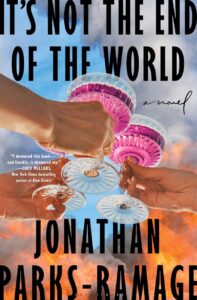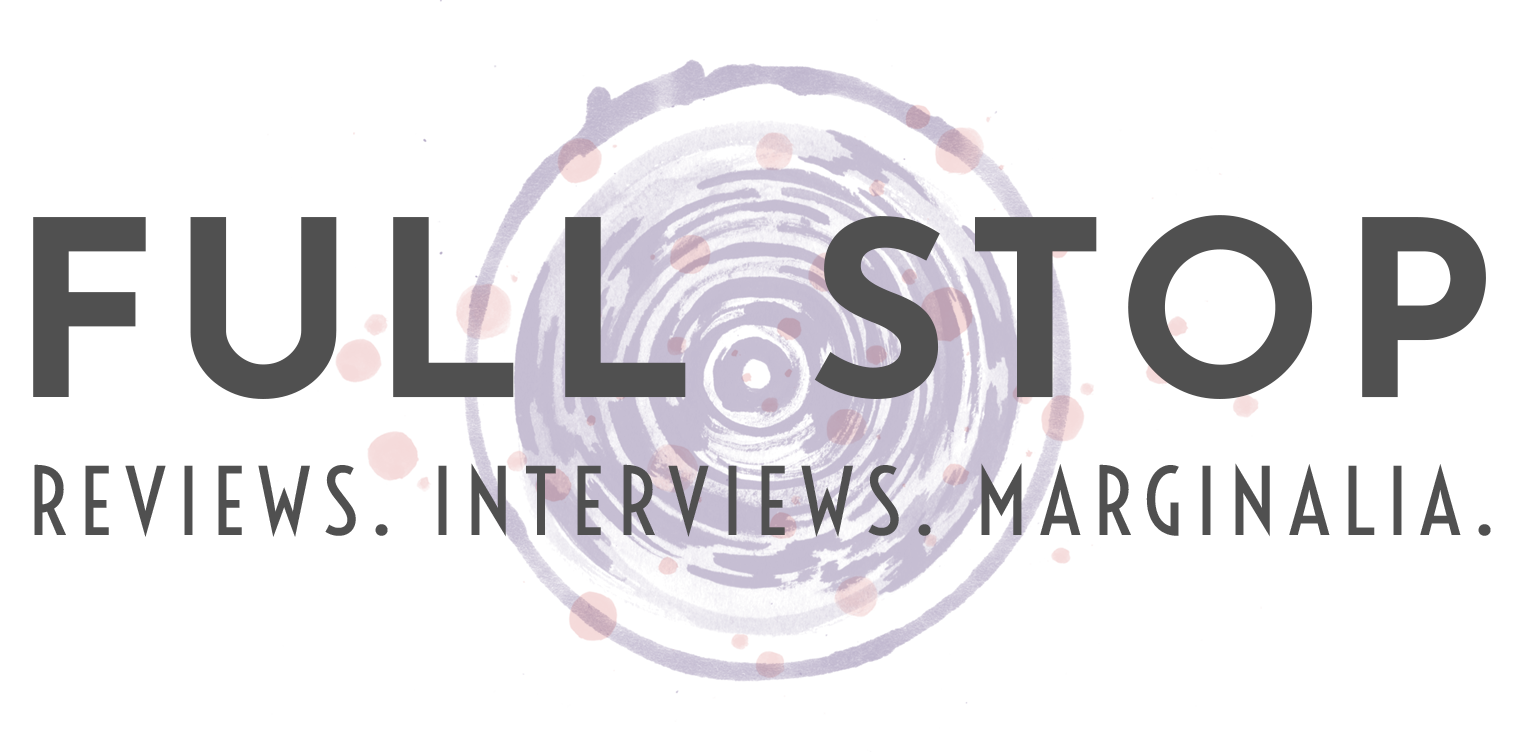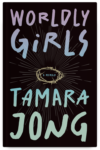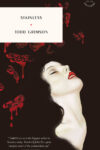
[Bloomsbury; 2025]
In Jonathan Parks-Ramage’s 2044, everything is pretty much how you expect it will be. Chris Pratt is governor of California. Gay marriage is illegal again. Los Angeles is always on fire, while Miami and Fire Island are entirely submerged. Siri feeds ads straight to your brain through Apple’s brain chip, iOS Cerebrum. Rich people hire weather modification companies to ensure the guests at their over-the-top, out-of-touch baby showers can stand outside to watch synchronized swimmers perform without wearing gas masks.
Then, a pink, chemical-laden smoke settles over LA, causing the people who breathe it in to undergo a transformation. They become violent, monstrous, attacking anything that moves and using their bare hands to destroy it, until they themselves are destroyed. Essentially, they become zombies. Meanwhile, the baby showers persist, until they too are enveloped by the pink smoke.
In It’s Not the End of the World, sell-out artist Mason Duant and his husband (in spirit, if no longer legally), Yunho Kim—a filmmaker who has recently been sued by the House Anti-American Speech Committee—are the rich couple throwing an obscene baby shower, under the delusion that there is a future into which they can happily bring a child. After Mason breathes in the pink smoke, he loses his vision to a wall of whiteness, then loses himself to a violent self-protective urge. With his bare hands, he murders the one man who still buys his tired art and sets off a chain of events that seal the fate of the planet and its occupants. Yunho, their surrogate Astrid, and a community of their friends move to a compound in Montana called the Ranch. When the narrative eventually jumps forward almost a hundred years—after battles with local militia and the FBI, after the climate degradation we all know is coming, after the upper class on earth colonizes Mars and figures out immortality via LyfeHack—the Ranch is an autonomous, bio-domed community of people who are tired of being alive, trapped in the ten square miles of the paradisical dome. They no longer see the point of having children.
In the first half of the book, before this society-shaping chain of events, Mason runs around LA trying to check things off his pre-baby shower to-do list while pink smoke turns regular people into arcade-game monsters. He picks up a flower arrangement, delivers a piece of art to his slimy benefactor, encounters a legless body squelching through the pink smoke like a slug on steroids, picks up the party cake, pays a VR dom with body mods that resemble an extinct species of wolf to degrade him, ignores phone calls from his mom, picks up Astrid and her wheelchair-bound partner Claudia, and dons a gas mask to push Claudia the last mile home when another wave of pink smoke turns LA drivers into monstrous caricatures of road-rage blindness, stopping traffic completely. He’s determined to get those flowers to his baby shower.
***
This isn’t Parks-Ramage’s first time narrating the queer horror of seeking the comfort promised in exchange for compliance with authority. His first novel, Yes, Daddy, is a gothic horror that reviewers warn not to take to bed with you. In it, a young gay playwright with nothing to lose begins a relationship with a successful older playwright. When he bids for freedom via allegiance with the older man, he learns just how much he had to lose after all.
While Yes, Daddy explores the social ramifications of self-abnegation, It’s Not the End of the World situates selling out within global climate and humanitarian contexts. Parks-Ramage roams through a number of perspectives: Mason’s, driven by the conflicted yearning for security; Gabriel’s, the child of Mason’s old friend and business partner, who was born into a world on fire and waits for dragons to save them; Claudia’s, as told through bittersweet but hopeful emails to the child Astrid carries; Sita’s, a surrogate in Gujurat organizing a surrogates union; a transcript of a community accountability circle at the Ranch; a manifesto from a jaded militia member. Parks-Ramage’s narration is direct and cinematic, physical and visceral. He fills the book with violence and doesn’t shy away from describing it, an approach that pre-sell-out Mason might have shared. In one of many expository ruminations, Mason remembers a series of porthole paintings he made as a college student:
Mason painted over sections of his face to give the illusion that whole swaths of skin were rotting off his skull, but instead of revealing his insides, these gaping wounds were portholes to an inner psychic space, windows containing sick tableaus—a panopticon stuffed with seal carcasses, a senator jerking his cock while getting face-fucked by a tank gun, a woman drowning in a sea of aborted fetuses. His classmates never liked these paintings, found them didactic and unsubtle, but Mason always felt that, well, the world was on fire so what was the point of being elliptical and academic?
***
i haven’t read a book that scared me so much since severance, I texted a friend after finishing the first half of It’s Not the End of the World. Then, like pressing on a bruise, like breathing in choking smoke instead of donning a gas mask, I decided to reread Severance.
Ling Ma’s debut was released in 2018. It takes place mostly in a fictive 2011, in an emptied-out New York after a spore-spread fever has turned the majority of the world’s population into pitiful, harmless zombies, repeating rote tasks like folding clothes or sending emails or setting tables, without doing any life-sustaining tasks like consuming healthy food or sharing meaningful connections. The main character, Candace, is pregnant, and one of very few who hasn’t yet contracted Shen Fever. She recounts her life story: immigrating from China as a small child, trying to be an artist in New York after college, giving up her practice to take a job producing bibles printed in Chinese factories, living her life while Shen Fever spread as though things would soon return to normal, and returning to photography only after there was no more work to be done, no more bibles to print, no more world to document—only emptiness and ruin. Meanwhile, she travels through a United States populated by zombies with a small group of un-fevered led by Bob, a manipulative narcissist who assures them all that they are special by virtue of their survival.
For a year after reading the book the first time, I would find my heart pounding in fear, unable for a moment to differentiate which world I lived in—the crumbled one Ling Ma made up, or the one where Shen Fever is a fiction.
What’s the difference between Mason and Candace? Both are former ambitious art students. Candace no longer makes photographs, but Bibles. Mason no longer makes art, but products. Both have abandoned their ambitions for the comfort of money. Mason acquiesces to a closeted patron who makes his money on the sale of poisonous farming chemicals (the unsurprising genesis of the pink smoke). Candace acquiesces to the world of factory production, where the economic bottom line eclipses worker safety (the genesis of Shen Fever, which developed in the poor working conditions of Chinese manufacturing factories). And both are committed to the existence of the future—a familiar, comfortable future, a future whose arch is shrinking to encompass only the next generation, the next decade, the next year, month, week, day, hour. This present is the future they want to maintain, for their children. Candace stays at her production job long past any production, committed to the contract she signed that would finance the life she wants for her baby. Mason sells out first to capitalism, then to the state, despite knowing that by doing so he’s killing most of the people he loves.
The biggest difference in these novels is probably not that one takes place in the ever-more-distant past of the very early aughts and one in the ever-closer future of 2044—in a not-so-grand scheme, those two time periods are the same time periods, minor extensions backwards and forwards of our present. Rather, the difference is in the two types of zombies each depicts: in Severance we pity the dissociated zombie, enacting its meaningless routine while its jaw rots off; in It’s Not the End of the World we fear the rage zombie, blinded by pain and driven by terror to destroy anything that moves.
***
Am I Mason and Candace? I traded in my non-profit library job for a job with yearly bonuses, a desk in my own home, and an undercurrent of immorality. I want children. I’ve written about this desire here before, a desire that consumes me while I watch friends and family, lovers and ex-lovers, become portals for new life and then take on the impossible task of teaching that new life what it is to be a person. But I also want to be a portal for something that moves on a much longer arch than the next generation.
Instead, I wake up for the same meeting every morning at 7:30 a.m. I edit the same articles, day after day. I ignore the news or I binge the news. I’m dull and dissociated, or I’m desperate and enraged.
So maybe I’m not Mason and Candace, but one of the zombies. But you’re a smart reader, so you already know where this is going, right? Mason and Candace are zombies, too.
If every novel about modern people is a novel about zombies because that’s what so many of us have become, then every novel about people is also a novel about babies, because that’s what we all once were. Every book takes place in a present that was once a future. We were the promise of the future until we were forced to survive it; whatever hopes our forebears had for us at the outset—whether to change the world into the paradise it could be or maintain it as the paradise it is or revert to it to the paradise they remembered—inevitably we arrive at a place where we are no longer the future, but the present. But by then, a new generation of babies has been born, a new league of the future for us to project our hopes onto.
The children are our future, the characters in these books argue, whether that’s because they’ll return us to a gilded (racist, classist, fascist) status quo or because they’ll usher us into a paradisical era of equality and human rights. In It’s Not the End of the World, political pundits and militias use the argument to target the Ranch, where children are allowed to choose their guardians, as a threat to the American family. In Severance, Bob uses the argument as an excuse to lock the potentially dissident Candace in isolation, for the sake of the baby. For the power-hungry, other people’s children are a rhetorical device and a future source of labor. For Mason and Candace, children represent their personal futures, the shapes of their lives going forward.
But what happens to these little futures when they’re no longer children, when they’re not the future anymore, but instead its dissociated, rageful, suffering past? While they don’t necessarily spout anti-natalist warnings, neither Parks-Ramage nor Ma offer a comforting image of the future of humanity. Both Mason and Candace end their stories powerless to enact systemic change, able only to replicate routine violence or succumb to it themselves.
***
I have quietly immersed myself in a less routine, less enraged world even while reading these two apocalypse novels, through Ursula le Guin’s experimental sci-fi “novel,” Always Coming Home. Taking on the role of an anthropologist creating an ethnographic document of the future, she explores a society occupying a northern California valley that has forgotten our own. With higher mortality rates, shorter lives, and fewer natural resources at their disposal, the people of the valley live in tandem with the natural world, respect it, and respect each other. This doesn’t mean that conflict doesn’t arise, or that routine doesn’t exist. But the people of the valley make a concerted effort not to return to the ways of living of their very distant ancestors—ourselves—the people who lived “outside of the world.”
But how do we get back into the world from where we are? Le Guin doesn’t give us a map. She can’t. She, like Parks-Ramage and Ma, and you and me, is stuck outside of it, too. I can’t give you a map, either. I can criticize Parks-Ramage and Ma for the hopelessness in their stories, but what would I have Mason do? Stop selling the art to the evil dude to make money to pay his mother’s mortgage? What would I have Candace do? Quit her job and go to the woods? That’s what I would do if the world was ending! But the world is ending, and I’ll still wake up tomorrow for my meeting.
Worlds end every day, and new worlds begin. I can’t reasonably claim that It’s Not the End of the World makes this argument, but if Parks-Ramage was entirely consumed by despair at our collective future, would he have even attempted to write this book? Writing this review (the one you’re reading) and having a baby are not, obviously, the same thing. But perhaps they resemble each other more than either resembles attending my morning meeting. And while, yes, sometimes I am driven by rage and sometimes by routine, I have one thing that zombies don’t: the desire to create something new.
Hannah Lamb-Vines reads, writes, and edits in Berkeley, California. They can be reached by email.
This post may contain affiliate links.






